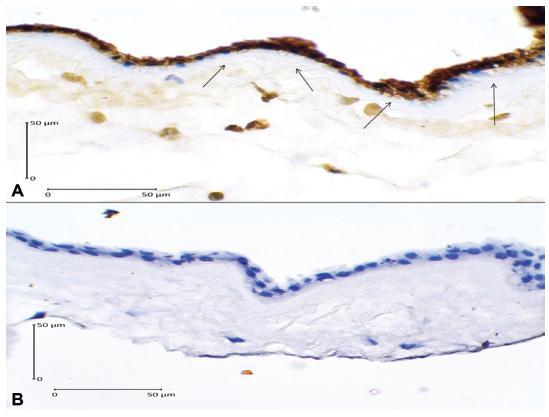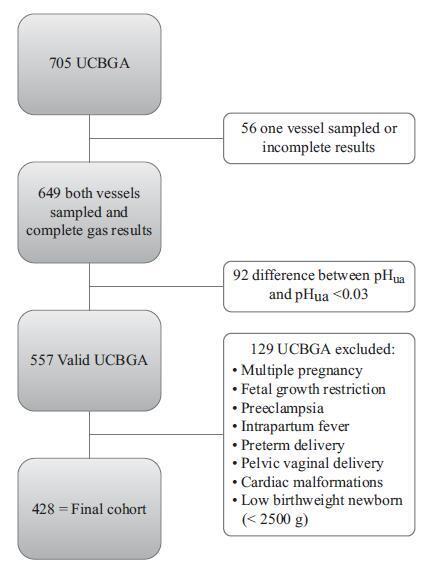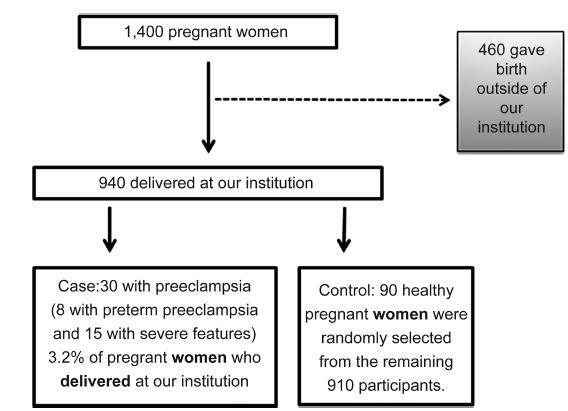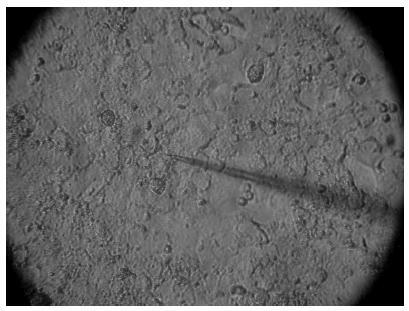-
Original Article02-01-2019
Syphilis in Pregnancy: The Reality in a Public Hospital
Revista Brasileira de Ginecologia e Obstetrícia. 2019;41(2):90-96
Abstract
Original ArticleSyphilis in Pregnancy: The Reality in a Public Hospital
Revista Brasileira de Ginecologia e Obstetrícia. 2019;41(2):90-96
Views274See moreAbstract
Objective:
The present study assessed epidemiological and obstetrical data from pregnant women with syphilis at the Hospital de Clínicas of the Universidade Federal do Triângulo Mineiro (UFTM, in the Portuguese acronym), describing this disease during pregnancy and its vertical transmission for future healthcare actions.
Methods:
Records from pregnant women who had been admitted to the Obstetrics Department of the Hospital de Clínicas of the UFTM and were diagnosed with syphilis between 2007 and 2016 were reviewed. A standardized form was used to collect epidemiological, obstetric data and outcomes of congenital infection. The present research has been authorized by the Ethics Committee of the institution.
Results:
There were 268 women diagnosed with syphilis, with an average age of 23.6 years old. The majority of the patients were from Uberaba. Inadequate prenatal care was observed in 37.9% of the pregnant women. Only 34.2% of the patients completed the treatment according to the guidelines issued by the Ministry of Health of Brazil, and 19.8% of the partners of the patients underwent adequate syphilis treatment; 37 (13.8%) couples (patients and partners) underwent correct treatment. Regarding the obstetric outcomes, 4 (1.5%) patients had a miscarriage and 8 (3.4%) had fetal losses (from the fetal loss group, 7 had no adequate treatment); 61 (25.9%) patients had premature births - this prematurity has been significantly correlated to inadequate or incomplete treatment in 49 (27.9%) patients, compared with 12 (13.0%) patients with premature births and adequate treatment (p = 0.006). The average live newborn weight was 2,840 g; 25.3% had a birth weight < 2,500 g; 74.2% had congenital syphilis, a data with heavy correlation to inadequate or incomplete prenatal care, prematurity, and low birth weight.
Conclusion:
Public awareness policies on adequate prenatal care, intensification of serological screening, and early treatment of syphilis are needed, considering the rise of cases diagnosed during gestation and its potentially preventable deleterious consequences related to congenital transmission.
-
Original Article02-01-2019
The Use of Mobile Educational Tools to Improve Antimicrobial Prescription for the Treatment of Acute Pyelonephritis in Pregnancy: A Retrospective Cross-sectional Study
Revista Brasileira de Ginecologia e Obstetrícia. 2019;41(2):97-101
Abstract
Original ArticleThe Use of Mobile Educational Tools to Improve Antimicrobial Prescription for the Treatment of Acute Pyelonephritis in Pregnancy: A Retrospective Cross-sectional Study
Revista Brasileira de Ginecologia e Obstetrícia. 2019;41(2):97-101
Views114See moreAbstract
Objective
To analyze the prescription of antimicrobial agents for pregnant women admitted into the obstetrics service who presented with acute pyelonephritis.
Methods
Three cross-sectional studies were performed comparing the prescription of antimicrobials for pyelonephritis in pregnant women in the time periods evaluated (2010-2011: 99 patients evaluated; 2013: 116 patients evaluated; 2015: 107 patients evaluated), at the Hospital Fêmina, Porto Alegre, in the state of Rio Grande do Sul, Brazil. The analysis was performed before and after the promotion of an institutional protocol for the treatment of pyelonephritis during pregnancy, and on a third occasion after the introduction of a smartphone-based mobile educational tool.
Results
The evaluation of the prescribing physicians and the adequacy of the prescriptions between the different periods studied revealed a significant increase in appropriate conduct for the choice of antimicrobial (2010: 83.8%; 2013: 95.7%; and 2015: 100%), route of administration (2010: 97%; 2013: 100%; and 2015: 100%), and interval (2010: 91.9%; 2013: 95.7%; and 2015: 100%), following the introduction of the protocol, and again after the implementation of the softwareapplicationwithorientationsontheantimicrobial treatment.
Conclusion
The use of specific mobile applications should be encouraged to attain a better quality and accuracy in prescriptions and to include strategies that not only reduce the risk of negative outcomes, but also improve the quality of care and treatment for maintaining the health both of the mother and of the baby.
-
Original Article12-12-2019
Pregnancy of Unknown Location: The Value of Frozen Section Analysis and Its Relation to Beta-hCG Levels and Endometrial Thickness
Revista Brasileira de Ginecologia e Obstetrícia. 2019;41(3):142-146
Abstract
Original ArticlePregnancy of Unknown Location: The Value of Frozen Section Analysis and Its Relation to Beta-hCG Levels and Endometrial Thickness
Revista Brasileira de Ginecologia e Obstetrícia. 2019;41(3):142-146
Views151See moreAbstract
Objective
Frozen section examination is a rapid method for identifying products of conception in endometrial curetting, yet its accuracy is inconclusive. The purposes of this study is to determine the accuracy of frozen section analysis of endometrial curetting in pregnancies of unknown location, and to verify the relation of β-human chorionic gonadotrophin (hCG) level and endometrial thickness to the assessed accuracy.
Methods
We reviewed data from January 2009 to December 2014 of diagnostic curettages from women with suspected ectopic pregnancies sent for frozen section examination at a medical center. A frozen section diagnosis was considered accurate if it concurred with the final pathologic diagnosis.
Results
Of 106 frozen section studies, the diagnosis was accurate in 94 (88.7%). Of 79 specimens interpreted as negative on frozen sections (no products of conception noted), 9 (11.4%) were positive on final pathologic review. Three of the 27 (11.1%) specimens interpreted as positive by a frozen section failed to demonstrate products of conception on a final pathologic section. The sensitivity of frozen sections in the diagnosis of ectopic pregnancy was 72.7%, specificity 95.9%, positive predictive value 88.9%, negative predictive value 88.6%, and accuracy 88.6%. A statically significant correlation was found between β-hCG level and high accuracy of the frozen section technique (p< 0.001). No correlation was found between endometrial thickness and the accuracy of the frozen section technique.
Conclusion
The accuracy of frozen section examination was high and was found to correlate with β-hCG level, but not with endometrial thickness.
-
Original Article12-01-2018
The Role of Caspase-3, Apoptosis-Inducing Factor, and B-cell Lymphoma-2 Expressions in Term Premature Rupture of Membrane
Revista Brasileira de Ginecologia e Obstetrícia. 2018;40(12):733-739
Abstract
Original ArticleThe Role of Caspase-3, Apoptosis-Inducing Factor, and B-cell Lymphoma-2 Expressions in Term Premature Rupture of Membrane
Revista Brasileira de Ginecologia e Obstetrícia. 2018;40(12):733-739
Views193See moreAbstract
Objective
To determine the role of caspase-3, apoptosis-inducing factor (AIF), and Bcell lymphoma-2 (Bcl-2) expressions in term premature rupture of membrane (PROM).
Methods
An analytic observational study with case-control design was conducted, involving 52 subjects (37-42 weeks of gestation) who were divided into 2 groups: 26 cases of term delivery with PROM, and 26 controls of term delivery without PROM. The expressions of caspase-3, AIF, and Bcl-2 in the amniotic membrane were determined by immunohistochemistry. Data were analyzed using the chi-squared test. The risk of PROM was expressed by odds ratio (OR).
Results
There were no significant differences in age, parity and body mass index between the two groups (p > 0.05). High caspase-3 and AIF expressions increased the risk of PROM 17.64 times (OR = 17.64; 95% CI = 4.44-70.07; p = 0.001) and 9.45 times (OR = 9.45; 95% CI= 2.62-34.07; p = 0.001), respectively, while low Bcl-2 expression increased 10.39 times (OR = 10.39; 95% CI = 2.73-39.56; p = 0.001)the risk of PROM .
Conclusion
High caspase-3 and AIF expressions and low Bcl-2 expression were risk factors for term PROM. Caspase-dependent and independent pathways of apoptosis were involved in the mechanism of PROM in term pregnancy.

-
Original Article12-01-2018
Umbilical Cord Blood Gas Analysis, Obstetric Performance and Perinatal Outcome
Revista Brasileira de Ginecologia e Obstetrícia. 2018;40(12):740-748
Abstract
Original ArticleUmbilical Cord Blood Gas Analysis, Obstetric Performance and Perinatal Outcome
Revista Brasileira de Ginecologia e Obstetrícia. 2018;40(12):740-748
Views200See moreAbstract
Objective
To analyze if umbilical artery pH (pHua) ≤7.00 and umbilical artery blood deficit (BDua) ≥12.00 mmol/L are good predictors of adverse neonatal outcomes.
Methods
This was an observational, longitudinal and retrospective cohort study, conducted at the department of obstetrics and gynecology of Centro Hospitalar Tondela Viseu between September 2013 and September 2015. Total cohort and subgroup analysis were performed: group A-women with umbilical cord blood gas analysis (UCBGA) performed for non-reassuring fetal cardiotocographic patterns, placental abruption, or shoulder dystocia; and group B-all the others. Assays were made with the software SPSS for Windows, Versions 20.0 and 21.0 (IBM Corp., Armonk, NY, USA).
Results
A total of 428 UCBGAs met the inclusion criteria. The group analysis revealed an association between group A and pHua ≤7.00, as well as between BDua ≥12.00 mmol/L and 1st minute Apgar score ≤4 (p = 0.011). After the application of the logistic regression models in the total cohort analysis, pHua ≤7.00 had an impact in the occurrence of acute neonatal hypoxia (odds ratio [OR]: 6.71; 95% confidence interval [CI]: 1.21-37.06; p = 0.029); multiparous women had a higher risk of delivering a newborn with first minute Apgar score ≤4 and acute neonatal hypoxia (OR: 5.38; 95% CI: 1.35-21.43; p = 0.017; and OR: 2.66; 95% CI: 1.03-6.89, p = 0.043, respectively); women who had urologic problems during pregnancy had a higher risk of delivering a newborn with 5th minute Apgar score ≤7 (OR: 15.17; 95% CI: 1.29-177.99; p = 0.030); and shoulder dystocia represented a 15 times higher risk of acute neonatal hypoxia (OR: 14.82; 95% CI: 2.20-99.60; p = 0.006).
Conclusion
The pHua and the BDua are predictors of adverse neonatal outcome, and UCBGA is a useful tool for screening newborns at risk. Universal UCBGA should be considered for all deliveries, as it is an accurate screening test for neonatal hypoxia.

-
Original Article12-01-2018
Association between Caffeine Consumption in Pregnancy and Low Birth Weight and Preterm Birth in the birth Cohort of Ribeirão Preto
Revista Brasileira de Ginecologia e Obstetrícia. 2018;40(12):749-756
Abstract
Original ArticleAssociation between Caffeine Consumption in Pregnancy and Low Birth Weight and Preterm Birth in the birth Cohort of Ribeirão Preto
Revista Brasileira de Ginecologia e Obstetrícia. 2018;40(12):749-756
Views255See moreAbstract
Objective
To describe caffeine consumption during pregnancy and its association with low birth weight (LBW) and preterm birth in the birth cohort of Ribeirão Preto, state of São Paulo, Brazil, in 2010.
Methods
Cohort study, with descriptive and analytical approach. Data included 7,607 women and their newborns in Ribeirão Preto, state of São Paulo, Brazil. The women answered standardized questionnaires about reproductive health, prenatal care, life habits, sociodemographic conditions, and information about coffee intake. The independent variable was high caffeine consumption (≥300 mg/day) from coffee during pregnancy, and the dependent variables were LBW (birth weight < 2,500 g) and preterm birth (< 37 weeks of gestational age). Four adjusted polytomous logistic regression models, relative risk (RR) and 95% confidence interval (CI) were fitted: biological and sociodemographic conditions; obstetric history; current gestational conditions; and all variables included in the previous models.
Results
A total of 4,908 (64.5%) mothers consumed caffeine, 143 (2.9%) of whom reported high consumption. High caffeine intake was significantly associated with reduced education and with the occupation of the head of the family, nonwhite skin color, not having a partner, higher parity, previous abortion and preterm birth, urinary tract infection, threatened abortion, alcohol consumption and smoking. No association was found between high caffeine consumption and LBW or preterm birth in both
Conclusion
In this cohort, high caffeine intake was lower than in other studies and no association with LBW or preterm birth was found.
-
Original Article12-01-2018
Circulating Tissue Inhibitor of Metalloproteinase-4 levels are not a Predictor of Preeclampsia in the period between 20 and 25 Weeks of Gestation
Revista Brasileira de Ginecologia e Obstetrícia. 2018;40(12):757-762
Abstract
Original ArticleCirculating Tissue Inhibitor of Metalloproteinase-4 levels are not a Predictor of Preeclampsia in the period between 20 and 25 Weeks of Gestation
Revista Brasileira de Ginecologia e Obstetrícia. 2018;40(12):757-762
Views190See moreAbstract
Objective
To evaluate whether the circulating level of tissue inhibitor of metalloproteinase- 4 (TIMP-4) in the period between 20 and 25 weeks of gestation is a predictor of preeclampsia.
Methods
We have performed a case-control study, nested in a prospective study cohort in Ribeirão Preto, in the state of São Paulo, Brazil. Of the 1,400 pregnant women evaluated between 20 and 25 weeks of gestation, 460 delivered in hospitals outside of our institution. Of the 940 pregnant women who completed the protocol, 30 developed preeclampsia. Healthy pregnant women (controls, n = 90) were randomly selected from the remaining 910 participants. From blood samples collected between 20 and 25 weeks of gestation, we performed a screening of 55 angiogenesis-related proteins in 4 cases and 4 controls. The protein TIMP-4 was the most differentially expressed between cases and controls. Therefore, wemeasured this protein in all cases (n = 30) and controls selected (n = 90).
Results
There were no differences in the plasma TIMP-4 levels of cases compared with controls (1,144 263 versus 1,160 362 pg/mL, respectively; p > 0.05).
Conclusion
Plasma TIMP-4 levels were not altered at 20 to 25 weeks of gestation, before the manifestation of clinical symptoms; therefore, they are not good predictors of the development of preeclampsia.

-
Original Article12-01-2018
Electrophysiological Responses to Different Follicle- Stimulating Hormone Isoforms on Human Cumulus Oophorus Cells: Preliminary Results
Revista Brasileira de Ginecologia e Obstetrícia. 2018;40(12):763-770
Abstract
Original ArticleElectrophysiological Responses to Different Follicle- Stimulating Hormone Isoforms on Human Cumulus Oophorus Cells: Preliminary Results
Revista Brasileira de Ginecologia e Obstetrícia. 2018;40(12):763-770
Views136See moreAbstract
Objective
The aim of the present study was to provide a better understanding of the specific action of two follicle-stimulating hormone (FSH) isoforms (β-follitropin and sheep FSH) on the membrane potential of human cumulus cells.
Methods
Electrophysiological data were associated with the characteristics of the patient, such as age and cause of infertility. The membrane potential of cumulus cells was recorded with borosilicate microelectrodes filled with KCl (3 M) with tip resistance of 15 to 25 MΩ. Sheep FSH and β-follitropin were topically administered onto the cells after stabilization of the resting potential for at least 5 minutes.
Results
In cumulus cells, the mean resting membrane potential was - 34.02 ± 2.04 mV (n = 14). The mean membrane resistance was 16.5 ± 1.8 MΩ (n = 14). Sheep FSH (4 mUI/mL) and β-follitropin (4 mUI/mL) produced depolarization in the membrane potential 180 and 120 seconds after the administration of the hormone, respectively.
Conclusion
Both FSH isoforms induced similar depolarization patterns, but β-follitropin presented a faster response. A better understanding of the differences of the effects of FSH isoforms on cell membrane potential shall contribute to improve the use of gonadotrophins in fertility treatments.



